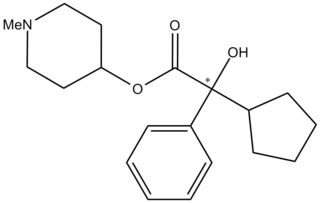3-Quinuclidinyl benzilate (QNB) is an odorless and bitter-tasting military incapacitating agent. BZ is an antagonist of muscarinic acetylcholine receptors whose structure is the ester of benzilic acid with an alcohol derived from quinuclidine.
Chemical, biological (CB) — and sometimes radiological — warfare agents were assigned what is termed a military symbol by the U.S. military until the American chemical and biological weapons programs were terminated. Military symbols applied to the CB agent fill, and not to the entire weapon. A chemical or biological weapon designation would be, for example, "Aero-14/B", which could be filled with GB, VX, TGB, or with a biological modification kit – OU, NU, UL, etc. A CB weapon is an integrated device of (1) agent, (2) dissemination means, and (3) delivery system.

From 1948 to 1975, the U.S. Army Chemical Corps conducted classified human subject research at the Edgewood Arsenal facility in Maryland. The purpose was to evaluate the impact of low-dose chemical warfare agents on military personnel and to test protective clothing, pharmaceuticals, and vaccines. A small portion of these studies were directed at psychochemical warfare and grouped under the prosaic title of the "Medical Research Volunteer Program" (1956–1975). The MRVP was also driven by intelligence requirements and the need for new and more effective interrogation techniques.

Benzilic acid is an organic compound with formula C
14H
12O
3 or (C
6H
5)2(HO)C(COOH). It is a white crystalline aromatic acid, soluble in many primary alcohols.

Dimethylheptylpyran is a synthetic analog of THC, which was invented in 1949 during attempts to elucidate the structure of Δ9-THC, one of the active components of Cannabis. DMHP is a pale yellow, viscous oil which is insoluble in water but dissolves in alcohol or non-polar solvents.

N-Methyl-3-piperidyl benzilate is an anticholinergic drug related to the chemical warfare agent 3-quinuclidinyl benzilate.

N-Ethyl-3-piperidyl benzilate (JB-318) is an anticholinergic drug related to the chemical warfare agent 3-Quinuclidinyl benzilate.

Ditran (JB-329) is an anticholinergic drug mixture, related to the chemical warfare agent 3-Quinuclidinyl benzilate (QNB).

EA-3167 is a potent and long-lasting anticholinergic deliriant drug, related to the chemical warfare agent 3-quinuclidinyl benzilate (QNB) and to the bronchodilator drug tiotropium bromide. It was developed under contract to Edgewood Arsenal during the 1960s as part of the US military chemical weapons program, in an attempt to develop non-lethal incapacitating agents. EA-3167 has identical effects to QNB, but is even more potent and longer-lasting, with an effective dose when administered by injection of as little as 2.5 μg/kg, and a duration of 120–240 hours. However unlike QNB, EA-3167 was never weaponized or manufactured in bulk.

The M43 BZ cluster bomb, or simply M43 cluster bomb, was a U.S. chemical cluster bomb intended to deliver the incapacitating agent known as BZ. The weapon was produced in the early 1960s and all stocks of U.S. BZ were destroyed by 1989.
Psychochemical warfare — or "drug weapons" — involves the use of psychopharmacological agents with the intention of incapacitating an adversary through the temporary induction of hallucinations or delirium. These agents have generally been considered chemical weapons and, more narrowly, constitute a specific type of incapacitating agent. Although never developed into an effective weapons system, psychochemical warfare theory and research—along with overlapping mind control drug research—was secretly pursued in the mid-20th century by the US military and Central Intelligence Agency (CIA) in the context of the Cold War. These research programs were ended when they came to light and generated controversy in the 1970s. The degree to which the Soviet Union developed or deployed similar agents during the same period remains largely unknown.

EA-3443 is a potent and long lasting anticholinergic deliriant drug, related to the chemical warfare agent 3-Quinuclidinyl benzilate (QNB). It was developed under contract to Edgewood Arsenal during the 1960s as part of the US military chemical weapons program, during research to improve upon the properties of earlier agents such as QNB.

CAR-302,196 is a moderately potent and relatively short lasting anticholinergic deliriant drug, related to the chemical warfare agent 3-Quinuclidinyl benzilate (QNB). It was developed under contract to Edgewood Arsenal during the 1960s as part of the US military chemical weapons program, during research to improve upon the properties of earlier agents such as QNB.

CAR-226,086 is a potent anticholinergic deliriant drug with a fairly long duration of action, related to the chemical warfare agent 3-quinuclidinyl benzilate (QNB). It was developed under contract to Edgewood Arsenal during the 1960s as part of the US military chemical weapons program, during research to improve upon the properties of earlier agents such as QNB.

EA-3834 is a potent anticholinergic deliriant drug with a fairly long duration of action, related to the chemical warfare agent 3-quinuclidinyl benzilate (QNB). It was developed under contract to Edgewood Arsenal during the 1960s as part of the US military chemical weapons program, during research to improve upon the properties of earlier agents such as QNB.

EA-3148 is a "V-series" nerve agent related to the better-known compounds VX and VR. It was studied by both the US and Soviet chemical weapons programmes during the Cold War, and is notable as the only V-series organophosphate nerve agent specifically identified in public domain sources as having a higher absolute potency as an acetylcholinesterase inhibitor than VX. However, both the US and Soviet investigations of the compound concluded that despite its high potency, the physicochemical properties of the substance made it unsuitable for weaponisation, and further research was not conducted.

CAR-301,060 is a potent and long lasting anticholinergic deliriant drug, related to the chemical warfare agent 3-Quinuclidinyl benzilate (QNB). It was developed under contract to Edgewood Arsenal during the 1960s as part of the US military chemical weapons program, during research to improve upon the properties of earlier agents such as QNB.

CS-27349, or L-2-α-tropinyl benzilate, is an experimental incapacitating agent. It acts as an antagonist to muscarinic acetylcholine receptors, causing delirium. It has 37% of the potency of the related compound 3-quinuclidinyl benzilate (BZ) in producing peripheral effects, but 85% of the potency in producing central effects. The mean dose required to incapacitate subjects was 1.2 times that of BZ. It has not been in use since the 1970s, and there have been no publications about its effects or long-term toxicology since then.

CAR-302,282 (302282, NSC-263548, α-(3-Methylbut-1-yn-3-enyl)mandelic acid 1-methyl-4-piperidyl ester) is an anticholinergic deliriant drug, invented under contract to Edgewood Arsenal in the 1960s. It is a potent incapacitating agent with an ED50 of 1.2μg/kg and a high central to peripheral effects ratio, and a relatively short duration of action compared to other similar drugs of around 6-10 hours. Despite its favorable properties it was relatively little researched compared to more high profile compounds from the series such as EA-3167 and EA-3580.
















